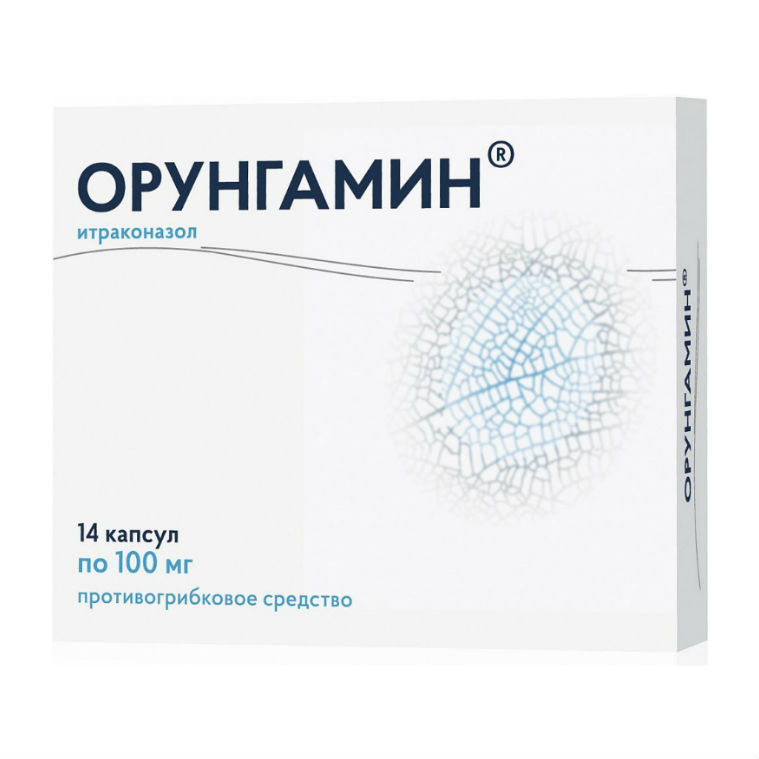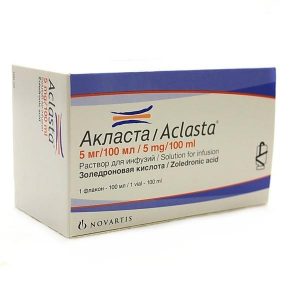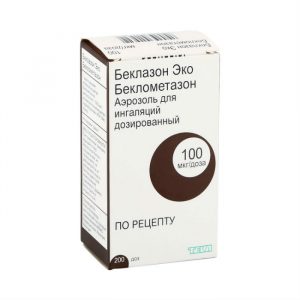Description
Pharmacological action
Itraconazole is a synthetic broad-spectrum antifungal agent derived from triazole. It inhibits the synthesis of ergosterol in the cell membrane of fungi, which leads to the antifungal effect of the drug.
Itraconazole is active against:
dermatophytes (Trichophyton spp, Microsporum spp, Epidermophyton floccosum),
yeast Candida spp. (including Candida albicans, Candida parapsilosis), mold
(Cryptococcus neoformans, Aspergillus spp., Trichosporon spp., Geotrichum spp., Penicillium mameffei, Pseudallescheria boydii, Histoplasma spp., Coccidioides immitis, Paracoccidioides braziliensis, Sporothrix schenckii. Fonsecaea spp., Cladosporium spp., Blastomyces dermatidis), Malassezia spp ..
Some strains may be resistant to itraconazole: C. glabrata, C. krusei, C. tropicalis, Absidia spp., Fusarium spp., Mucor spp., Rhizomucor spp .. Rhizopus spp., Scedosporium proliferans, Scopulariopsis spp .. The effectiveness of treatment is evaluated after 2-4 weeks. after discontinuation of therapy (with systemic mycoses), after 6-9 months. – with onychomycosis (as the nails change).
Pharmacokinetics
When administered orally, the maximum bioavailability of itraconazole is observed when capsules are taken immediately after a meal. The maximum plasma concentration is reached within 3-3.5 hours after oral administration and is 28.34 ng / ml. With prolonged use, an equilibrium concentration is achieved within 1-2 weeks. Itraconazole is 99.8% bound to plasma proteins. The concentration of itraconazole in the blood is 60% of the concentration in plasma. The accumulation of the drug in keratin tissues, especially in the skin, is about 4 times higher than the accumulation in plasma, and its excretion rate depends on the regeneration of the epidermis.
Unlike plasma concentrations that cannot be detected as early as 7 days after discontinuation of therapy, therapeutic concentrations in the skin persist for 2-4 weeks after discontinuation of the 4-week course of treatment. Itraconazole is found in keratin of nails already one week after the start of treatment and persists for at least 6 months after completing a 3-month course of therapy. Itraconazole is also determined in sebum and to a lesser extent in sweat.
Itraconazole is well distributed in tissues that are susceptible to fungal infections. Concentrations in the lungs, kidneys, liver, bones, stomach, spleen and muscles were 2-3 times higher than the corresponding plasma concentrations. The therapeutic concentrations in the vaginal tissues are maintained for another 2 days after the completion of the 3-day course of treatment at a dose of 200 mg per day, and 3 days after the end of the one-day course of treatment at a dose of 200 mg twice a day. Itraconazole is metabolized in the liver with the formation of active metabolites, including hydroxyitraconazole. It is an inhibitor of isoenzymes CYP3A4, CYP3A5 and CYP3A7.
Excretion from plasma – two-phase: by the kidneys for 1 week. (35% as metabolites, 0. 03% – unchanged) and through the intestines (3-18% unchanged). The elimination half-life is 1-1.5 days. It is not removed during dialysis.
Indications
skin and mucous membrane lesions: dermatomycosis vulvovaginal candidiasis
versicolor versicolor,
oral mucosa candidiasis keratomycosis
deep visceral candidiasis.
onychomycosis caused by dermatophytes and / or yeast and molds:
systemic mycoses:
systemic aspergillosis and candidiasis
cryptococcosis (including cryptococcal meningitis): in patients with immunodeficiency and in all patients, it is only necessary to have cryptosis cases if first-line drugs are not applicable in this case or
histoplasmosis
sporotrichosis
paracoccidioidosis
blastomycosis
other rare systemic mycoses are not effective.
Contraindications
1. Hypersensitivity to itraconazole or excipients.
2. Chronic heart failure, including history (with the exception of therapy for life-threatening conditions).
3. Concomitant use of the following drugs:
drugs metabolized by the CYP3A4 isoenzyme that can extend the QT interval (astemizole, bepridil, cisapride, dofetilide, levacetylmethadol, misolastine, pimozide, quinidine, sertindole, terfenfidin, gerfenfidin, terfenfidin) metabolized by CYP3A4 isoenzyme (simvastatin, lovastatin)
oral administration of triazolam and midazolam
ergot alkaloids (dihydroergotamine, ergometrine, ergotamine and methylergometrin)
nisoldriptine,
4. Children’s age up to 3 years.
5. Fructose intolerance, sucrose / isomaltase deficiency, glucose-galactose malabsorption.
CAUTION – renal / hepatic insufficiency, peripheral neuropathy, risk factors for chronic heart failure (coronary heart disease, damage to heart valves, severe lung diseases, including chronic obstructive pulmonary disease, conditions accompanied by edema syndrome), hearing impairment, simultaneous use of blockers of “slow” calcium channels, children and the elderly.
Special instructions
To prevent reinfection, simultaneous treatment of sexual partners and personal hygiene are necessary. During treatment, it is recommended to refrain from sexual intercourse. If signs of infection persist after treatment is completed, a repeated microbiological examination should be performed to confirm the diagnosis.
The efficacy of itraconazole for the treatment of fungal infections in severe neutropenia is unknown, therefore, in such cases, the drug should be used only if the 1st line of therapy is ineffective.
If there are risk factors for chronic heart failure (coronary heart disease, heart valve damage, severe lung disease, including chronic obstructive pulmonary disease, conditions accompanied by edema syndrome), therapy should be discontinued during treatment with itraconazole.
When taking itraconazole in some patients, transient and permanent deafness was noted.
1 capsule of Orungamine contains 4 bread units (XE).
Composition
Per 1 capsule:
itraconazole pellets 455 mg (Active ingredient: itraconazole 100 mg, Excipients: hypromellose (hydroxypropyl methylcellulose E-5), butyl methacrylate, dimethylaminoethyl methacrylate and methyl methacrylate copolymer [1: 2: 1] (Eudragit E-100), sucrose (sugar)).
Hard gelatin capsules No. 0.
Composition of capsules: case: gelatin lid: dye indigo carmine, titanium dioxide, gelatin.
Side effects
From the hemopoietic organs: leukopenia, neutropenia, thrombocytopenia.
Allergic reactions: serum sickness, angioedema, anaphylactic and anaphylactoid reactions, hypersensitivity.
From the skin: toxic epidermal necrolysis, Stevens-Johnson syndrome, erythema multiforme, exfoliative dermatitis, leukoclastic vasculitis, alopecia, photosensitivity, urticaria, rash, itching.
From the side of metabolism: hypertriglyceridemia, hypokalemia.
From the nervous system: peripheral neuropathy, paresthesia, hypesthesia, dizziness.
From the organs of vision and hearing: visual impairment, including vagueness and diplopia, tinnitus, transient or permanent deafness.
From the cardiovascular system: congestive heart failure.
From the respiratory system: pulmonary edema.
From the digestive system: abdominal pain, vomiting, nausea, diarrhea, violation of taste perception, increased activity of ² Ñliver ² Ñ enzymes dyspepsia, constipation, hepatitis, hyperbilirubinemia, hepatotoxicity, acute liver failure.
From the side of the musculoskeletal system: myalgia, arthralgia.
From the genitourinary system: pollakiuria, urinary incontinence, menstrual irregularities, erectile dysfunction.
Other: edema.
Overdose
Data not available. In case of accidental overdose during the first hour after taking the drug, gastric lavage should be carried out, activated charcoal should be taken.
Symptomatic treatment. Hemodialysis is not effective. There is no specific antidote.
Storage conditions
Store in a dry, dark place at a temperature not exceeding 25 ° C. Keep out of the reach of children.
Expiration
3 years. Do not use after expiration date
Active substance
Itraconazole
drugstore conditions
drugstore
Dosage form
capsules



